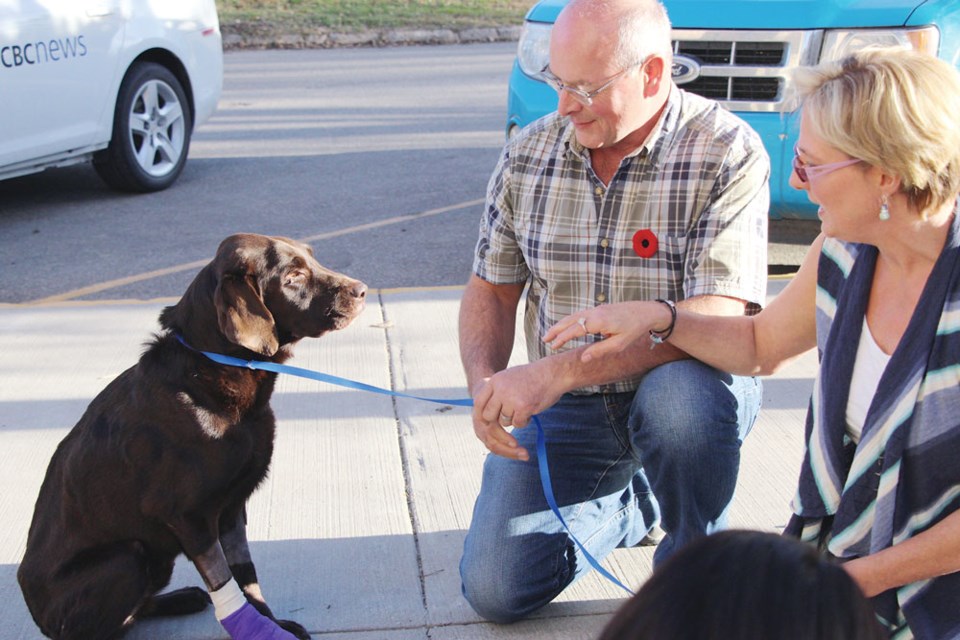People across the world have been introduced this fall to the miraculous story of Bruno, the seven-year-old chocolate Labrador retriever who spent 27 days trapped at the bottom of a well at his family’s farm near Hitchcock.
And they cheered when his owners, the Billesberger family, were able to bring him home on Nov. 10, after spending 22 days at the Western College of Veterinary Medicine’s (WCVM) Veterinary Medical Centre (VMC) at the University of Saskatchewan.
Bruno was initially admitted to the WCVM on Oct. 19, just a few days after he was rescued. He had been receiving care from the capable staff at the Prairie Animal Health Centre’s (PAHC) Estevan and Weyburn locations. Bruno had to be referred to the WCVM after bloodwork showed his phosphorous levels were dangerously low.
He received specialized care 24 hours a day from the WCVM included small animal internal medicine specialists, a clinical nutritionist, canine rehabilitation therapists, small animal surgeons and the VMC’s intensive care unit (ICU). Students were also involved with the treatment.
Dr. Sue Taylor, an internal medicine specialist and professor of small animal medicine at the WCVM, said she hasn’t seen many cases that required so many different care teams to be involved.
“He’s a pretty unique case in that his problems were numerous, and there were different people who specialized in each little facet of his care,” said Taylor.
At the same time, a case like this brings attention to the number of specialists they have, and the care they can provide.
As it turned out, Bruno was suffering from refeeding syndrome, a condition seen in human, and, in some cases, with cats, but very rarely diagnosed in dogs. In fact, Bruno marked the first time she had seen the medical issue in a dog.
“That’s certainly the thing that he was at risk of actually killing him,” said Taylor.
Dogs that do suffer from refeeding syndrome are usually animals that were abused, neglected or abandoned. That certainly wasn’t the case for Bruno, who was trapped in an abandoned well that nobody knew was on the property.
“I’ve treated quite a few cats that had a much milder version of refeeding syndrome, when they had not wanted to eat for a week or more, and then we put in feeding tubes and things like that,” said Taylor.
They referenced literature on the refeeding syndrome in cats and humans, and used those documented treatments to handle Bruno. The specialists carefully increased the amount of food he could receive, and properly supplemented his intake of essential electrolytes, including phosphorous, magnesium and potassium.
His electrolyte levels were constantly monitored and supplemented intravenously, until they stabilized. The process took two and a half weeks. His digestive system was also extremely sensitive to the new food that was introduced.
The sores on Bruno’s paws were also an issue. They developed when he tried to claw his way out of the well. Sores also occurred from sitting in the well water for nearly a month.
Cold laser therapy treated the wounds, which accelerated healing, reduced pain and helped him avoid surgery to remove damaged tissue. An operation would have been difficult due to his delicate condition.
“We were worried about his feet when he first came in, and looked at them, but they came along very quickly, and it became clear, after he was only here for three or four days, that he wasn’t going to require surgery,” said Taylor.
Bruno spent more time at the WCVM than Taylor initially anticipated, because it took more time than expected to get his phosphorous and magnesium under control. But his strength and attitude made significant strides in his last five or six days in Saskatoon.
Now that he’s gone, the staff at the WCVM miss him, she said, because he was such a big part of their work.
“Every day, there were a few of us who would take him outside for a walk so that we could see how his strength was coming along, and how his attitude was coming along, and his lameness from his foot,” said Taylor. “It’s just something that to not have him in the ICU when we go down there is unusual.”
The people in the rehabilitation department missed him in particular, she said, because they were with him for 30 to 60 minutes every day.
But they’re excited he’s back with his family.
“That’s where he belongs,” said Taylor.
Taylor and two other veterinarians – Dr. Alison Khoo and Dr. Tammy Owens – plan to collaborate on a scientific case report documenting Bruno’s recovery. It could help other veterinarians facing the issue of refeeding syndrome in dogs.
Khoo is the small animal internal medicine resident veterinarian who managed Bruno’s case, while Owens is a clinical nutritionist who helped with the issues surrounding refeeding syndrome.
Khoo has already written the main part of the report, and Owens and Taylor will make some additions and revisions. The document should be finished in the next two or three weeks.
“The main reason we’re doing this is we had quite a challenge trying to figure out exactly how we’re going to manage him,” said Taylor.
As for the Billesberger family, they are thrilled to be reunited with their beloved family dog, and they had high praise for the care Bruno received in Estevan, Weyburn and Saskatoon.
“They’re an amazing group up in Saskatoon, and everybody’s been helpful all the way along,” said Billesberger. “We had to stop in Weyburn on the way home to get his bandage changed, so the vet that actually helped care for him eventually got to have a visit with him looking a lot better, so she was excited to see him in this kind of shape.”
Bruno still has to get weighed by a veterinarian every two days to make sure he is gaining appropriate weight, so his care, from the local front anyways, is far from over.




